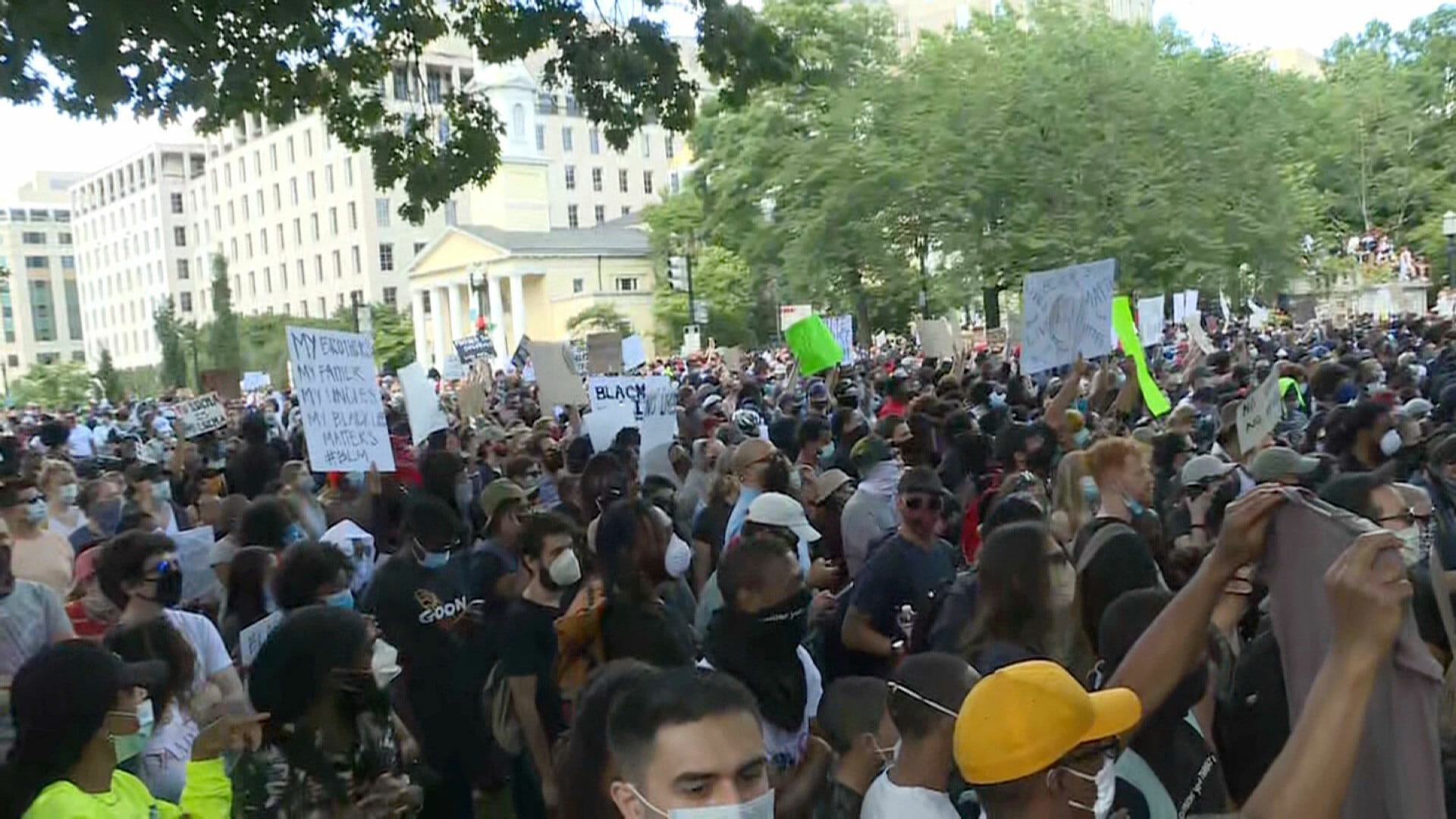
Protestors gather near St. John’s Episcopal Church, across the street from Lafayette Park in Washington, D.C.
Photograph courtesy of CNN.
Living in two Americas, what did we see?

Rev. Daniel Headrick
June 4, 2020
I could barely believe what I was seeing and hearing, but there it was for all to see who had eyes to see and ears to hear. Federal police violently repelled and assaulted a crowd of peaceful protestors outside the White House. The President of the United States delivered an address in the Rose Garden as the concussive boom of munitions could be plainly heard. Smoke, tears, and shouts filled the air.
George Floyd’s name was uttered, and then just as quickly subsumed by the real narrative: law and order. In words that were as enigmatic as they were vintage Trump, he said “We have one, beautiful law. And once that is restored and fully restored, we will help you, we will help your business, and we will help your family.” Homage was paid to the “Second Amendment”, a catchphrase of our era that smoothly elided the First Amendment it was meant to suppress.
And then to conclude his remarks, the President said, “and now I am going to pay my respects to a very, very special place.”
That special place turned out to be St. John’s Episcopal Church, just across the street in Lafayette Park. A portion of the church had been set ablaze by unknown rioters the night before. As the protestors fled amidst tear gas and advancing police, the President and an entourage of civilian leaders crossed the street through a phalanx of guards dressed in paramilitary regalia. It was a perverse triumphal entry of sorts to the front of the boarded-up St. John’s. Having crossed the Rubicon, Trump brandished a Bible, holding it up and rotating it. One half expected him to toss it in the air to the delight of his entourage.
It became clear as the moment unfolded that the violence had been orchestrated precisely so that the President could stride unmolested to St. John’s. We would later learn that the former rector of St. John’s was one of the victims of tear gassing as she labored to provide water to marchers. “They turned holy ground into a battleground,” she said.
The priest’s interpretation struck me as sound. And yet, what seemed as clear as day to me, that what we saw was a state sanctioned use of violence in contravention of the First Amendment right to peaceably assemble, all for a craven and blasphemous co-opting of St. John’s Episcopal Church and the Bible, was not so clear to others.
A reporter for the Atlantic spoke with Robert Jeffress, the pastor of FBC Dallas by phone, who robustly defended the President’s actions: “I thought it was completely appropriate for the president to stand in front of that church…And by holding up the Bible, he was showing us that it teaches that, yes, God hates racism, it’s despicable—but God also hates lawlessness.”
Jeffress, who is one of the foremost proponents of Christian nationalism in America, and a Trump whisperer as it were, has a reliable finger on the white evangelical pulse. Notice that the President did not need to say any words while he stood in front of the church. The content of the symbolism was self-interpreting within the closed hermeneutical world of Christian nationalism.
We live in two Americas. One in which police brutality against people of color continues unabated and unaddressed. And another in which there are no permissible grounds for protesting white supremacy, whether taking a knee during the anthem or chanting “Black Lives Matter” in front of the White House.
Those who “stand” for the Bible—irrespective of what the Bible actually says—are upholding societal order. The belief that the Bible underwrites the American project, from 1619 until 2020, is a key tenet of Christian nationalism. Jesus died, in such a theology, so that America could be great again.
That Christian nationalism intersects so cleanly with white supremacy should not surprise us, as white supremacy has served as one of the foundations of the American experience. So, what was seen depends entirely on one’s theological lens. Either a lawless man with no visible fruit of the spirit clutched a symbol of faith as police violence filled the streets or a godly man who wishes only to restore order and to protect your family stood up for God and Country against lawlessness. Both visions cannot be true, and yet both are potent interpretations held by millions.
A person shows you again and again who they are and yet millions will say “shame on you! You cannot know this person’s heart!” A person opens his mouth and from it comes lies and hatred and yet millions will say “this person stands for God.” As Hannah Arendt and Timothy Snyder have shown us, truth is the first casualty in an authoritarian regime. In Snyder’s little gem of a book “On Tyranny: Twenty Lessons from the Twentieth Century,” lesson 10 is “Believe in the truth.” “You submit to tyranny when you renounce the difference between what you want to hear and what is actually the case.”[i] Gaslighting is the lingua franca of our poisonous age. You did not really see what you claimed to have seen.
The following day the President and his campaign showed us for the thousandth time how gaslighting works: they attempted to shift the debate to whether “teargas” was actually used on the protestors. The CDC classifies the specific type of munition launched at the protestors as tear gas. The semantic debate roared on, obfuscating the underlying matter of police brutality.
Notice that similar tactics are used in every other debate of national importance. A gunman shoots up a school or a movie theater, brutally murdering human beings. Then you are suddenly debating with a high school classmate about the specific definition of an “assault weapon” as if that were the thing that mattered most when a child is being buried. This is another way in which we “see” totally different worlds. Because we have the whole world at our fingertips, we are so easily lost in the minutiae of meaningless factual distinctions, and therefore blind to what really matters.
Jesus taught his followers that their fidelity to the truth was such that they did not need to swear an oath in order for people to believe their word. “Let your word be ‘Yes, Yes’ or ‘No, No’; anything more than this comes from the evil one.” (Matthew 5:37). And yet, Christians seem very fond of swallowing the most ludicrous of conspiracy theories and gaslighting their neighbor, while simultaneously ignoring acts of injustice that are playing out on TV screens around the globe.
What I and millions of other Americans saw on Monday, June 1st, 2020, was not what millions of other Americans saw.
What did we see? How to exegete this particular moment?
Well, the sad truth is that “we” saw completely different things. Perhaps this is a given of human experience. Nothing is self-interpreting. Events in the world beg for interpretation. All that we see and hear is suffused with meaning that itself presupposes a whole complex history, namely ours. A light reading of postmodern theory will get you there quickly enough.
The fact that we see things so differently is no excuse for Christians to cease speaking and acting for the marginalized and oppressed. Competing narratives and arguments concerning what we should be doing is at the very heart of our shared life. Disagreement is but a sign that what we are talking about matters.
Add these ingredients to an already complex recipe: hyper-partisan political rhetoric combined with toxic social media during a global pandemic; echo chambers and disinformation campaigns; politics of outrage and selective memory. All potent forces that contribute to our seeing things differently.
In such an environment, persuasion through commonly agreed upon procedural methods like rational argumentation, a factual record, and shared values may seem naive. Why resort to such methods when the goal is not persuasion so much as it is drawing a tighter boundary around the community of which you are a part? No wonder that each side retreats to their community of solidarity and defectors are rare and idiosyncratic. Only fools would dare stand in the gap and attempt rapprochement between parties who have shown who they are again and again.
Perhaps the only fact we can agree on is that we cannot agree. “These are the facts of the case, and they are undisputed,” as Tom Cruise’s character said in A Few Good Men.
This is our tragedy and this is our plight. We live in two Americas. One in which police brutality against people of color continues unabated and unaddressed. And another in which there are no permissible grounds for protesting white supremacy, whether taking a knee during the anthem or chanting “Black Lives Matter” in front of the White House.
This is a moment of clarity for the Church, for pastors who have a calling to speak up when it matters, and for congregants who have avoided tough conversations. The gaslighting of God will not stand. God sees us exactly as we are: sinful, biased, blinded.
Because we affirm that every human being is made in the image of God and worthy of dignity and love, because in Christ Jesus there is “no longer Jew or Greek, there is no longer slave or free, there is no longer male and female” (Gal. 3:28), because “whoever does not love does not know God, for God is love” (1 John 4:8)…because we are tired of being silent, we will not abide silence in the face of lynching and white supremacy. We will keep our eyes focused on the injustice that is being perpetrated in our land. We will not be distracted by inevitable gaslighting and meaningless distinctions.
We labor for justice as Christians in this earthly city, knowing that true justice in its fullness will not come until “all things are subjected to him, then the Son himself will also be subjected to the one who put all things in subjection under him, so that God may be all in all.” (1 Cor. 15:28).
The fact that we see things so differently is no excuse for Christians to cease speaking and acting for the marginalized and oppressed. Competing narratives and arguments concerning what we should be doing is at the very heart of our shared life. Disagreement is but a sign that what we are talking about matters.
Do not despair that you see things differently than others do. We are perhaps all blinded by our idolatry to political powers which hold more sway over our lives than Jesus Christ. Perhaps the question “what did we see?” is the wrong one. Perhaps we should ask for new vision to transform our racism and ideological blinders.
Perhaps we should ask for God’s vision, because “before him no creature is hidden, but all are naked and laid bare to the eyes of the one to whom we must render an account.” (Hebrews 4:13) Truthfully, our vision is occluded by sin and human frailty. But God sees things clearly. God sees us all exactly as we are.
I wonder what God saw when George Floyd was viciously murdered?
When Ahmaud Arbery was lynched?
When an emperor strode through a phalanx of soldiers brandishing the Word of God?
The Rev. Daniel Headrick is associate pastor of Northside Drive Baptist Church, Atlanta, Georgia. Prior to joining Northside Drive, he practiced civil litigation with a law firm in Knoxville, Tennessee. He is a former fellow of both the Baptist Joint Committee for Religious Liberty and the Fellowships at Auschwitz for the Study of Professional Ethics.
The views expressed are those of the author and not necessarily those of American Baptist Home Mission Societies.
[i] Timothy Snyder, On Tyranny: Twenty Lessons from the Twentieth Century p. 66.


